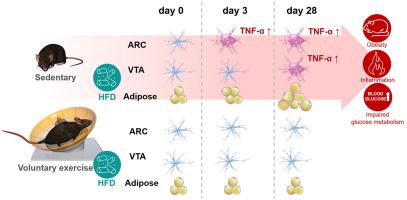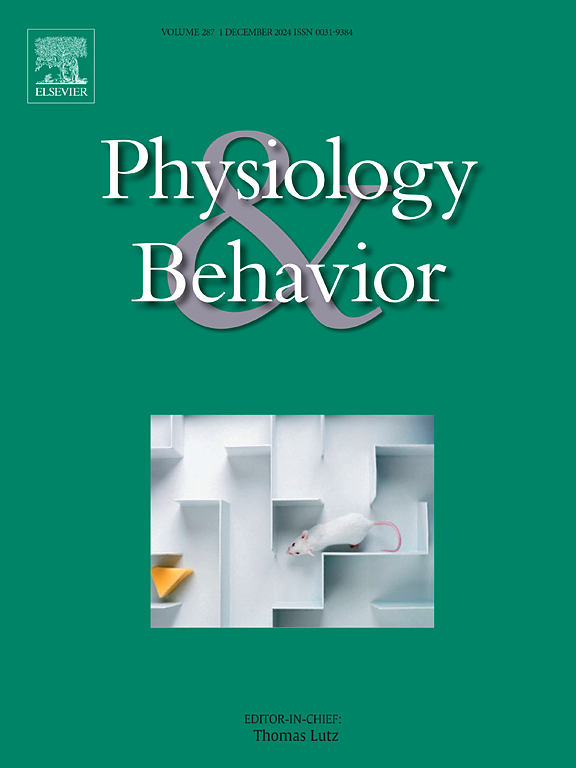Voluntary exercise suppresses inflammation and improves insulin resistance in the arcuate nucleus and ventral tegmental area in mice on a high-fat diet
IF 2.4
3区 医学
Q2 BEHAVIORAL SCIENCES
引用次数: 0
Abstract
A high-fat diet (HFD) causes inflammation with an increase in microglial activity in the hypothalamic arcuate nucleus (ARC) and ventral tegmental area (VTA), resulting in insulin resistance in both regions. This leads to a deterioration in glucose and energy metabolism. The effect of voluntary exercise on HFD-induced inflammation in the central nervous system (CNS) remains unclear. To clarify the effects of voluntary exercise on the CNS, 8-week-old male C57BL6 mice were fed a chow diet (CHD) or HFD for 4 weeks; each group was further divided into running exercise (EX+) on a wheel and no exercise (EX-) groups. The expression of the inflammatory cytokine, tumor necrosis factor alpha (TNFα), in the ARC and VTA was significantly increased in the HFD/EX- group, with an increase of microglial activity noted, compared to the CHD/EX- group. The expression of TNFα was significantly suppressed, with a decrease of microglial activity, in the HFD/EX+ compared to HFD/EX- group. Insulin resistance in the ARC and VTA was improved with the suppression of TNFα expression. The HFD/EX- group showed significant weight gain and impaired glucose metabolism compared to the CHD/EX- group. The HFD/EX+ group showed an improvement in glucose and energy metabolism compared to the HFD/EX- group. In addition, voluntary wheel running suppressed HFD-induced inflammation in the ARC, with a decrease in microglial activity observed independently of weight changes. Our data suggest that voluntary exercise prevents obesity and improves glucose metabolism by suppressing inflammation in the ARC and VTA under HFD conditions.

自愿运动可抑制炎症并改善高脂饮食小鼠弓状核和腹侧被盖区的胰岛素抵抗。
高脂饮食(HFD)会导致下丘脑弓状核(ARC)和腹侧被盖区(VTA)的炎症和小胶质细胞活性增加,从而导致这两个区域的胰岛素抵抗。这导致葡萄糖和能量代谢恶化。自主运动对高密度脂蛋白胆固醇诱导的中枢神经系统(CNS)炎症的影响仍不清楚。为了弄清自主运动对中枢神经系统的影响,研究人员给 8 周大的雄性 C57BL6 小鼠喂食饲料(CHD)或 HFD 4 周;每组小鼠又分为在车轮上跑步运动(EX+)组和不运动(EX-)组。与CHD/EX-组相比,HFD/EX-组小鼠ARC和VTA中炎症细胞因子肿瘤坏死因子α(TNFα)的表达明显增加,小胶质细胞活性也有所提高。与HFD/EX-组相比,HFD/EX+组的TNFα表达明显受到抑制,小胶质细胞活性降低。随着TNFα表达的抑制,ARC和VTA的胰岛素抵抗得到改善。与CHD/EX-组相比,HFD/EX-组的体重明显增加,糖代谢受损。与HFD/EX-组相比,HFD/EX+组的葡萄糖和能量代谢有所改善。此外,自愿轮跑抑制了HFD诱导的ARC炎症,观察到小胶质细胞活性降低,而与体重变化无关。我们的数据表明,在HFD条件下,自主运动可抑制ARC和VTA的炎症,从而预防肥胖并改善糖代谢。
本文章由计算机程序翻译,如有差异,请以英文原文为准。
求助全文
约1分钟内获得全文
求助全文
来源期刊

Physiology & Behavior
医学-行为科学
CiteScore
5.70
自引率
3.40%
发文量
274
审稿时长
47 days
期刊介绍:
Physiology & Behavior is aimed at the causal physiological mechanisms of behavior and its modulation by environmental factors. The journal invites original reports in the broad area of behavioral and cognitive neuroscience, in which at least one variable is physiological and the primary emphasis and theoretical context are behavioral. The range of subjects includes behavioral neuroendocrinology, psychoneuroimmunology, learning and memory, ingestion, social behavior, and studies related to the mechanisms of psychopathology. Contemporary reviews and theoretical articles are welcomed and the Editors invite such proposals from interested authors.
 求助内容:
求助内容: 应助结果提醒方式:
应助结果提醒方式:


